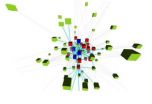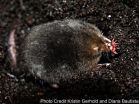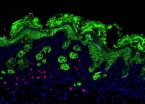(Press-News.org) On January 30, 2013 ACS Nano published a study by Ali Khademhosseini, PhD, MASc, Brigham and Women's Hospital Division of Biomedical Engineering, detailing the creation of innovative cardiac patches that utilize nanotechnology to enhance the conductivity of materials to induce cardiac tissue formation. Creation of these ultra-thin cardiac patches put medicine a step closer to durable, high-functioning artificial tissues that could be used to repair damaged hearts and other organs.
The cardiac tissue patches utilize a hydrogel scaffolding reinforced by nanomaterials called carbon nanotubes. To create the patches, the researchers seeded neonatal rat heart muscle tissue onto carbon nanotube-infused hydrogels. These novel patches showed excellent mechanical integrity and advanced electrophysiological functions. Moreover, they demonstrated a protective effect against chemicals toxic to heart tissue.
### Dr. Khademhosseini will be available to speak with the media. To schedule an interview please contact Marjorie Montemayor-Quellenberg, Brigham and Women's Hospital Senior Research Communications Specialist at (617) 534-2208 or mmontemayor-quellenberg@partners.org.
Nanomaterials key to developing stronger artificial hearts
2013-01-31
ELSE PRESS RELEASES FROM THIS DATE:
Pediatric orthopaedic surgeons show age-related patterns of spine injury in ATV injuries
2013-01-31
Memphis, Tenn. – Children continue to account for a disproportionate percentage of morbidity and mortality from ATV-related accidents – up 240 percent since 1997, according to a Journal of Pediatric Orthopaedics report published by pediatric orthopaedic surgeons at Le Bonheur Children's Hospital.
The surgeons – who studied data from the Kids' Inpatient Database – found spine-related injuries from all-terrain vehicles (ATVs) in the United States are more common in older children and in females, unlike males in most trauma studies. ATV-related spine injuries in children ...
Researcher uncovers potential cause, biomarker for autism and proposes study to investigate theory
2013-01-31
NEW YORK, NY — A New York-based physician-researcher from Touro College of Osteopathic Medicine, best known for his research into fertility and twinning, has uncovered a potential connection between autism and a specific growth protein that could eventually be used as a way to predict an infant's propensity to later develop the disease. The protein, called insulin-like growth factor (IGF), is especially involved in the normal growth and development of babies' brain cells. Based on findings of prior published studies, Touro researcher Gary Steinman, MD, PhD, proposes that ...
Working alone won't get you good grades
2013-01-31
Students who work together and interact online are more likely to be successful in their college classes, according to a study published Jan. 30 in the journal Nature Scientific Reports and co-authored by Manuel Cebrian, a computer scientist at the Jacobs School of Engineering at the University of California San Diego.
Cebrian and colleagues analyzed 80,000 interactions between 290 students in a collaborative learning environment for college courses. The major finding was that a higher number of online interactions was usually an indicator of a higher score in the class. ...
Adding new members to group increases distrust among older members, impacts coordination
2013-01-31
Adding a new member to a working group can create distrust between members and hinder group functions, but a new study suggests that the distrust created is between older group members rather than about the newcomers- especially when previous group performance with just the older group members is poor. The results are part of a study published January 30 in the open access journal PLOS ONE by Matthew McCarter and Roman Sheremeta from Chapman University (U.S).
Previous studies report that changing members in an existing group hurts group performance, but the underlying ...
Leading by the nose: Star-nosed mole reveals how mammals perceive touch, pain
2013-01-31
The most sensitive patch of mammalian skin known to us isn't human but on the star-shaped tip of the star-nosed mole's snout. Researchers studying this organ have found that the star has a higher proportion of touch-sensitive nerve endings than pain receptors, according to a study published January 30 in the open access journal PLOS ONE by Diana Bautista and colleagues from the University of California, Berkeley and Vanderbilt University.
Touch and pain are closely intertwined sensations, but very little is known about how these sensations are detected in our cells. In ...
Chimp see, chimp learn: First evidence for chimps improving tool use techniques by watching others
2013-01-31
VIDEO:
This video shows the "dipping " technique performed by chimpanzee Ayumu. Note that he uses his mouth to insert the tube into the bottle. In form, his technique is identical to...
Click here for more information.
Chimps can learn more efficient ways to use a tool by watching what others do, according to research published January 30 in the open access journal PLOS ONE by Shinya Yamamoto and colleagues from Kyoto University and Kent University, UK. Their study ...
Tapeworm eggs discovered in 270 million year old fossil shark feces
2013-01-31
A cluster of tapeworm eggs discovered in 270-million-year-old fossilized shark feces suggests that intestinal parasites in vertebrates are much older than previously known, according to research published January 30 in the open access journal PLOS ONE by Paula Dentzien-Dias and colleagues from the Federal University of Rio Grande, Brazil.
Remains of such parasites in vertebrates from this era are rare- of 500 samples examined, only one revealed the tapeworm eggs. This particular discovery helps establish a timeline for the evolution of present-day parasitic tapeworms ...
Pact invests US $109 million to secure critical genetic material, maintain global food production
2013-01-31
Contact: Michelle Geis
mgeis@burnesscommunications.com
301-280-5712
Contact: Susan Tonassi
301-280-5711
stonassi@burnesscommunications.com
Pact invests US $109 million to secure critical genetic material, maintain global food production
CGIAR consortium partners with global crop diversity trust to revitalize genebanks housing scores of crops considered essential to food security
BONN, GERMANY (31 JANUARY 2013)—Concerned that inconsistent funding eventually could weaken a global network of seed banks at a time when farmers face unprecedented challenges, two ...
Forsyth scientists gain new understanding of latent tuberculosis
2013-01-31
Scientists at the Forsyth have gained new insight on how Tuberculosis (TB) remains a global epidemic. Although drugs have been available to fight TB for 50 years, the disease still infects nearly 2.2 billion people worldwide and causes 1.7 million annual deaths. This is largely attributed to the bacteria's ability to stay dormant in the human body and later resurface as active disease. The Forsyth team, and its collaborators from Stanford University, has recently discovered that Mycobacterium tuberculosis, the bacteria that causes TB, can lay dormant and thrive within ...
Itching for new help for eczema: Recently identified immune cells possible therapeutic target
2013-01-31
PHILADELPHIA - The increasing incidence of allergic skin diseases, and the accompanying economic burden and heightened risk of developing other allergic conditions, have spurred researchers to look for better ways to control these immune system-based disorders.
Atopic dermatitis, more commonly called eczema, now affects 10 to 20 percent of children in the United States and direct health-care costs exceed $3 billion, according to the National Institute of Arthritis and Musculoskeletal and Skin Diseases. What's more, up to 50 percent of children with atopic dermatitis ...


